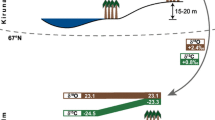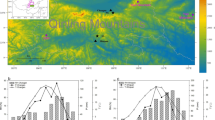Abstract
We investigated the dendroclimatic potential of stable carbon (δ13C) and oxygen (δ18O) abundances in tree rings of Callitris columellaris F. Muell. Tree-ring chronologies were constructed from the central Pilbara, north-western Australia and span 1919–1999. Variation in δ18O was more strongly related to climate than δ13C; ecological and physiological factors may have dampened the climate signal in the δ13C chronology. Tree-ring δ18O was most strongly correlated with relative humidity (RH) and rainfall (r = −0.36 and −0.39) of the wettest months of the summer period, January and February. The correlation with RH reflects its effect on evaporative enrichment of leaf water. However, tree-ring δ18O may also partly reflect the variability in 18O signatures of rainfall, which are influenced by the amount of rainfall and atmospheric humidity. From the δ18O chronology, we inferred that from 1919 to 1955 summers were relatively dry and warm, but since 1955, summers in the Pilbara region have become increasingly cooler and more humid. Since 1980, conditions have been the wettest and coolest of the last 80 years. These inferred changes in climate correspond to a measured increase in rainfall since 1980 in north-western Australia associated with a greater intensity of tropical cyclones. We conclude that δ18O abundances in tree rings of C. columellaris have significant potential for reconstructing the climate of semi-arid Australia, a region for which observational climate records are sparse.
Similar content being viewed by others
References
Allison GB, Barnes CJ, Hughes MW (1983) The distribution of deuterium and 18O in dry soils 2. Experimental. J Hydrol 64:377–397
Anderson WT, Bernasconi SM, McKenzie JA, Saurer M (1998) Oxygen and carbon isotopic record of climatic variability in tree ring cellulose (Picea abies): An example from Central Switzerland (1913–1995). J Geophys Res 103:31625–31636
Anderson WT, Bernasconi SM, McKenzie JA, Saurer M, Schweingruber F (2002) Model evaluation for reconstructing the oxygen isotopic composition in precipitation from tree ring cellulose over the last century. Chem Geol 182:121–137
Ash J (1983) Tree rings in tropical Callitris macleayana F. Muell. Aust J Bot 31:277–281
Attiwill PM, Clayton-Greene KA (1984) Studies of gas exchange and development in a subhumid woodland. J Ecol 72:285–294
Barber VA, Juday GP, Finney BP, Wilmking M (2004) Reconstruction of summer temperatures in interior Alaska from tree-ring proxies: evidence for changing synoptic climate regimes. Clim Change 63:91–120
Barbour MM, Farquhar GD (2000) Relative humidity- and ABA-induced variation in carbon and oxygen isotope ratios of cotton leaves. Plant Cell Environ 23:473–485
Barbour MM, Walcroft AS, Farquhar GD (2002) Seasonal variation in δ13C and δ18O of cellulose from growth rings of Pinus radiata. Plant Cell Environ 25:1483–1499
Biondi F, Waikul K (2004) DENDROCLIM2002: A C++ program for statistical calibration of climate signals in tree-ring chronologies. Comput Geol 30:303–311
Bowman DMJS, Harris S (1995) Conifers of Australia’s dry forests and open woodlands. In: Enright NJ, Hill RS (eds) Ecology of the southern conifers. Melbourne University Press, Melbourne, pp 252–270
Buchmann N, Kao W-Y, Ehleringer JR (1997) Influence of stand structure on carbon-13 of vegetation, soils, and canopy air within deciduous and evergreen forests in Utah, United States. Oecologia 110:109– 119
Bureau of Meteorology (2001) Australia’s global climate observing system. Bureau of Meteorology, Melbourne
Burrows WH, Hoggmann MB, Compton JF, Back P (2001) Allometric relationship and community stocks in white cypress pine (Callitris columellaris) and associated eucalypts of the Carnarvon area – South Central Queensland. National Carbon Accounting System Technical Report no. 33. Australian Greenhouse Office, Canberra
Cernusak LA, Farquhar GD, Pate JS (2005) Environmental and physiological controls over oxygen and carbon isotope composition of Tasmanian blue gum, Eucalyptus globulus. Tree Physiol 25:129–146
Chimmer RA, Cooper DJ (2004) Using stable oxygen isotopes to quantify the water source used for transpiration by native shrubs in the San Luis Valley, Colorado USA. Plant Soil 260:225–236
Cook ER, Bird T, Peterson M, Barbetti M, Buckley B, D’Arrigo RD, Francey R, Tans P (1991) Climatic change in Tasmania inferred from a 1089-year tree-ring chronology of Huon pine. Science 253:1266–1268
Cullen LE, Macfarlane C (2005) Comparison of cellulose extraction methods for analysis of stable-isotope ratios of carbon and oxygen in plant material. Tree Physiol 25:619–625
Dansgaard W (1964) Stable isotopes in precipitation. Tellus 16:436–468
Dawson TE (1993) Water source of plants as determined by xylem–water isotopic composition: Perspectives on plant competition, distribution, and water relations. In: Ehleringer JR, Hall AE, Farquhar GD (eds) Stable isotopes and plant carbon–water relations. Academic, San Diego, pp 465–496
Dawson TE, Mambelli S, Plamboeck AH, Templer PH, Tu KP (2002) Stable isotopes in plant ecology. Ann Rev Ecolog Syst 33:507–559
Dunwiddie PW, LaMarche VC (1980) Dendrochronological characteristics of some native Australian trees. Aust For 43:124–135
Eberbach PL (2003) The eco-hydrology of partly cleared, native ecosystems in Southern Australia: A review. Plant Soil 257:357–369
Edwards TWD, Graf W, Trimborn P, Stichler W, Lipp J, Payer HD (2000) δ13C response surface resolves humidity and temperature signals in trees. Geochim Cosmochim Acta 64:161–167
Farquhar GD, Ehleringer JR, Hubick KT (1989) Carbon isotope discrimination and photosynthesis. Annu Rev Plant Physiol Plant Mol Biol 40:503–537
Fessenden JE, Ehleringer JR (2002) Age-related variations in δ13C of ecosystem respiration across a coniferous forest chronosequence in the Pacific Northwest. Tree Physiol 22:159–167
Francey RJ, Allison CE, Etheridge DM, Trudinger CM, Enting IG, Leuenberger M, Landgenfelds RL, Michel E, Steele LP (1999) A 1000-year high precision record of δ13C in atmospheric CO2. Tellus 51B:170–193
Fritts HC (1976) Tree rings and climate. Academic, London
Gentilli J (1971) Climate of Australia and New Zealand. Elsevier, Amsterdam
Gray J, Thompson P (1977) Climatic information from 18O/16O analysis of cellulose, lignin and whole wood from tree rings. Nature 270:708–709
Hennessy KJ, Suppiah R, Page CM (1999) Australian rainfall changes, 1910–1999. Aust Meteorol Mag 48:1–13
Hill SA, Waterhouse JS, Field EM, Switsur VR, Aprees T (1995) Rapid recycling of triose phosphates in oak stem tissue. Plant Cell Environ 18:931–936
Hughes L (2003) Climate change and Australia: Trends, projections and impacts. Austral Ecol 28:423–443
IAEA (2002) Statistical treatment of data on environmental isotopes in precipitation. IAEA, Vienna
IPCC (2001) Climate change 2001: impacts, adaptation and vulnerability, contribution of working group II to the third assessment report of the intergovernmental panel on climate change. Cambridge University Press, Cambridge and New York
LaMarche VC, Holmes R, Dunwiddie PW, Drew LG (1979) Tree-ring chronologies of the Southern Hemisphere 4. Australia. Laboratory of Tree-Ring Research, University of Arizona, Chronology Series V
Leavitt SW, Long A (1989) Drought indicated in carbon-13/carbon-12 ratios of south-western tree rings. Water Resour Bull 25:341–347
Linacre E (1992) Climate data and resources: A reference and guide. Routledge, London
Luo Y-H, Sternberg LSL (1992) Hydrogen and oxygen isotopic fractionation during heterotrophic cellulose synthesis. J Exp Bot 43:47–50
Macfarlane C, Adams MA (1998) δ13C of wood in growth-rings indicates cambial activity of drought-stressed trees of Eucalyptus globulus. Funct Ecol 12:655–664
McCarroll D, Loader NJ (2004) Stable isotopes in tree rings. Quat Sci Rev 23:771–801
Nakatsuka T, Ohnishi K, Hara T, Sumida A, Mitsuishi D, Kurita N, Uemura S (2004) Oxygen and carbon isotopic ratios of tree-ring cellulose in a conifer-hardwood mixed forest in Northern Japan. Geochem J 38:77–88
Noy-Meir I (1973) Desert ecosystems: Environment and producers. Ann Rev Ecolog Syst 4:25–51
Panek JA, Waring RH (1997) Stable carbon isotopes as indicators of limitations to forest growth imposed by climate stress. Ecol Appl 7:854–863
Pearman GI, Francey RJ, Fraser PJB (1976) Climatic implications of stable carbon isotopes in tree rings. Nature 260:771–772
Pearson SG, Searson MJ (2002) High-resolution data from Australian trees. Aust J Bot 50:431–439
Pearson S, Searson M, Gayler L (2001) Preliminary results from tree increment and playa sediment cores from the Paroo, North-Western New South Wales, Australia. Quat Int 83–85:145–153
Perlinski JE (1986) The dendrochronology of Callitris columellaris F. Muell. in arid, sub-tropical continental Western Australia, MA thesis, University of Western Australia, Perth
Pittock B (2003) Climate change: An Australian guide to the science and potential impacts. Australian Greenhouse Office, Canberra
Plummer N, Salinger JM, Nicholls N, Suppiah R, Hennessy KJ, Leighton RM, Trewin B, Page CM, Lough JM (1999) Changes in climate extremes over the Australian region and New Zealand during the twentieth century. Clim Change 42:183–202
Raffalli-Delerce G, Masson-Delmotte V, Dupouey J-L, Stievenard M, Breda N, Moisselin JM (2004) Reconstruction of summer droughts using tree-ring cellulose isotopes: A calibration study with living oaks from Brittany (Western France). Tellus 56B:160–174
Ramesh R, Chattacharya SK, Gopalan K (1986) Climatic correlations in the stable isotope records of silver fir (Abies pindrow) trees from Kashmir, India. Earth Planet Sci Lett 79:66–74
Robertson I, Waterhouse JS, Barker AC, Carter AHC, Switsur VR (2001) Oxygen isotope ratios of oak in East England: Implications for reconstructing the isotopic composition of precipitation. Earth Planet Sci Lett 191:21–31
Roden JS, Lin G, Ehleringer JR (2000) A mechanistic model for interpretation of hydrogen and oxygen isotopes ratios in tree-ring cellulose. Geochim Cosmochim Acta 64:21–35
Saurer M, Borella S, Leuenberger M (1997) δ18O of tree rings of beech (Fagus sylvatica) as a record of δ18O of the growing season precipitation. Tellus 49B:80–92
Stafford Smith DM, Morton SR (1990) A framework for the ecology of arid Australia. J Arid Environ 18:225–278
Sternberg L, DeNiro MJ, Savidge RA (1986) Oxygen isotope exchange between metabolites and water during biochemical reactions leading to cellulose synthesis. Plant Physiol 82:423–427
Stokes MA, Smiley TL (1968) An introduction to tree-ring dating. University of Chicago Press, Chicago
Suppiah R (2004) Trends in the southern oscillation phenomenon and Australian rainfall and changes in their relationship. Int J Climatol 24:269–290
Yakir D (1992) Variations in the natural abundance of oxygen-18 and deuterium in plant carbohydrates. Plant Cell Environ 15:1005–1020
Yakir D (1998) Oxygen-18 of leaf water: A crossroad for plant-associated isotopic signals. In: Griffiths H (ed) Stable isotopes: Integration of biological, ecological and geochemical processes. BIOS Scientific, Oxford, pp 147–168
Zhang X, Liu J, He Y, Tian L, Yao T (2005) Humidity effect and its influence on the seasonal distribution of precipitation δ18O in monsoon regions. Adv Atmos Sci 22:271–277
Author information
Authors and Affiliations
Corresponding author
Rights and permissions
About this article
Cite this article
Cullen, L.E., Grierson, P.F. A stable oxygen, but not carbon, isotope chronology of Callitris columellaris reflects recent climate change in north-western Australia. Climatic Change 85, 213–229 (2007). https://doi.org/10.1007/s10584-006-9206-3
Received:
Accepted:
Published:
Issue Date:
DOI: https://doi.org/10.1007/s10584-006-9206-3




